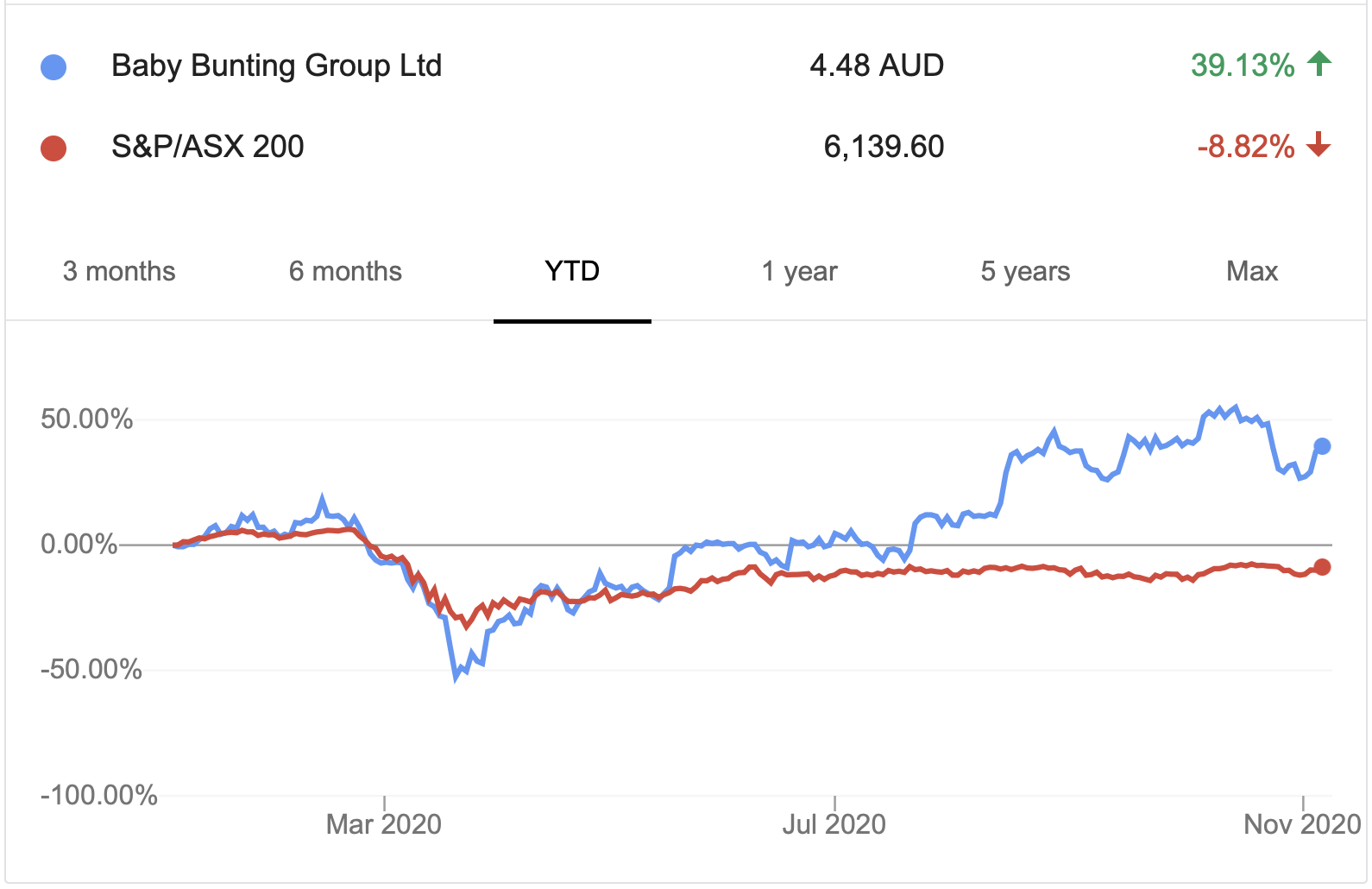The Baby Bunting Group Ltd (ASX: BBN) share price has made a rapid recovery compared to the broader S&P/ASX 200 (ASX: XJO) this year.
Here’s why I think Baby Bunting shares could be a great long-term addition to an ASX investor’s portfolio.

Baby Bunting is an Australian retailer of baby goods that distributes its products through both physical stores and an online offering. It primarily caters to parents with children from newborn to three years of age. Baby Bunting currently operates out of 57 stores but plans to grow its capacity to 100 stores over the next several years.
I know I’m sounding like a broken record here… but like many ASX retailers, the Baby Bunting share price suffered the same fate as most others due to the panic concerning whether bricks and mortar stores would be able to stay afloat during nationwide lockdowns. Luckily, government stimulus and superannuation withdrawals fuelled recent sales growth that was facilitated by Baby Bunting’s online sales channel.
COVID-19 – headwind or tailwind?
While some commentators have predicted that the 2020 lockdowns and having people stuck in their homes could cause a short-term increase in birth rates, others have pointed out that even prior to COVID-19, the fertility rate was actually falling. On top of this, the nation’s population is currently shrinking due to the rapid shutdown of immigration into the country.
Whatever the situation is in reality, Baby Bunting’s management has indicated that birth rates and immigration aren’t the only key drivers that are going to propel the company’s earnings growth into the future.
The company is said to have only around 15% market share in an estimated total addressable market of around $2.4 billion. Some of its main competitors are Amazon (NASDAQ: AMZN), Kogan.com Ltd (ASX: KGN), and Catch, however, Baby Bunting states it’s differentiated by its extremely popular click & collect method, private and exclusive labels and a store-based fulfilment method for online orders.
The current growth strategy isn’t driven by the underlying economics of immigration or birth rates. Rather, it’s focused on gaining market share by the further development of the company’s online platform, as well as the continued rollout of new physical stores across the country.
Baby Bunting plans to open four to eight stores per year, with the goal of operating 100+ stores at some point. It does currently only ship products to New Zealand, but the company has hinted at the idea that physical stores may be introduced at some point in the future.
Skin in the game
Non-executive directors Gary Levin and Ian Cornell both recently sold a small portion of their holdings in October this year, however collectively still hold 750,000 shares between them. While insider selling can often be a bad sign, I think the small sell-off given the fairly stretched valuation is justified.
Interestingly, over 47% of team members within the company are shareholders of Baby Bunting, as the company has continually offered a generous employee share plan to its staff.
CEO and managing director Matt Spencer owns 1.1 million shares, worth around $5 million based on the current share price.
Baby Bunting valuation
I have created a basic financial model to get a general idea of where the Baby Bunting share price will be in the years to come. I have deliberately chosen to use less than ideal growth assumptions so that there is an added margin of safety in the valuation.

The model assumes that future revenue generated is a function of the number of stores in operation. In reality, this isn’t completely accurate, as online sales growth is an increasingly important component of overall revenue. However, I have decided to omit this element as using “store only” growth will result in a more conservative outcome.
I’ve used historical data to get an average per store revenue amount, which then populates the revenue in the forecast years based on the number of stores that will be in operation at the time (averaging 6 new stores per year).
Net income can then be calculated based on an average net profit margin of 6%. I chose this number because management has indicated that it plans to grow margins over time, but again, I’m keeping it conservative.
Right now, Baby Bunting trades on a price-earnings ratio of over 30, but historically, it has traded on around 25x earnings. I’m going to assume after some of the recent hype dies down there will be some sort of mean reversion around the 25x mark, so I will calculate the implied market capitalisation by multiplying the forecast earnings by 25.
If I then divide the market capitalisation by the number of shares outstanding, I can calculate a rough share price target.
If management follows through with the 100 store goal, it looks like this may be achievable around 2027, with an estimated target price of around $9 and a compound annual growth rate (CAGR) of 10.55%. The model is conservative because it assumes revenue per store will remain constant and it doesn’t take into account how online channels will further drive revenue.
Limitations
While it is conservative, it must be pointed out that this valuation uses past results which are extrapolated out into forecast years. It doesn’t take into consideration competition risk or any other unforeseen event that could severely impact the profitability of newly-opened stores.
It does make logical sense that more stores open means higher earnings, but it’s not guaranteed.
Along with this, the valuation assumes that investors will be willing to pay 25 times earnings for Baby Bunting shares all the way out to 2027.
Buy/hold/sell?
I like Baby Bunting shares and I would like to own them. But as I pointed out earlier, relative to earnings, the price tag is historically high. Earnings are forecasted to grow, so the high price of shares might be justified.
I would buy Baby Bunting shares right now, but admittedly, they are expensive. I would definitely be holding for a long time to fully realise the growth potential from the continued rollout of new stores and the development of its online platform.











